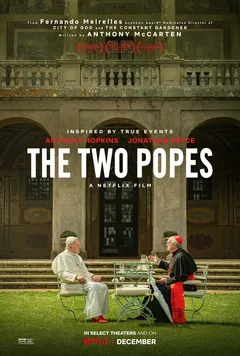Historical accuracy of The Two Popes

Historical accuracy of The Two Popes

Characters
Cardinal Jorge Bergoglio / Pope Francis
Based on the real figure. Pryce captures Bergoglio's perceived humility, pastoral focus, and progressive leanings relative to Benedict. However, the extensive private meetings and specific dialogues with Benedict depicted are fictionalized. His controversial past during Argentina's Dirty War is addressed, reflecting real historical scrutiny.
Pope Benedict XVI
Based on the real figure. Hopkins portrays Benedict's intellectualism, traditionalism, and the burden of the papacy leading to his resignation. While capturing some essence, the intimate friendship and specific conversations with Bergoglio shown are largely dramatic invention.
Father Franz Jalics
Based on the real Jesuit priest who, along with Orlando Yorio, was kidnapped during the Dirty War. The film depicts Bergoglio's complex and debated role in relation to their abduction.
Father Orlando Yorio
Based on the real Jesuit priest kidnapped alongside Jalics. His fate and relationship with Bergoglio are part of the historical events explored in the flashbacks.
Esther Ballestrino
Based on the real Esther Ballestrino de Careaga, a Paraguayan activist and mentor to Bergoglio who was disappeared during the Dirty War. Bergoglio's efforts concerning her are depicted in flashback.
Cardinal Turkson
Based on the real Cardinal Peter Turkson, shown as a prominent figure during the conclave scenes.
More characters
Cardinal Sodano
Based on the real Cardinal Angelo Sodano, shown presiding over aspects of the conclave.
Sister Sophia
Appears to be a fictional character representing nuns or assistants working with Cardinal Bergoglio in Argentina.
Story
Bergoglio wants to resign as Cardinal (2012)
Bergoglio did submit his resignation upon turning 75, as is standard, but the film dramatizes this as a crisis of faith and desire to escape, prompting his summons to Rome. The extended meeting with Benedict about it is fictional.
Extended private meetings/debates between Benedict & Bergoglio
The core of the film – these intimate, extensive dialogues at Castel Gandolfo and the Vatican where they debate theology, confess sins, and forge a friendship – are entirely fictionalized by screenwriter Anthony McCarten for dramatic effect.
Benedict reveals intention to resign to Bergoglio
While Benedict did resign, there is no evidence he confided his specific intention to Bergoglio in this manner beforehand or sought his input as depicted.
Theological differences between Benedict and Bergoglio
The film effectively portrays the generally perceived theological and stylistic differences: Benedict as the conservative academic defender of tradition, Bergoglio as the more pastoral, reform-minded figure focused on the poor.
Flashbacks to Bergoglio's past in Argentina (Dirty War)
The film depicts Bergoglio's controversial actions as Jesuit Provincial during Argentina's military dictatorship (1976-83), including his complex relationship with priests Jalics and Yorio who were kidnapped. The historical details and Bergoglio's exact role remain subjects of debate and interpretation.
Bergoglio's efforts regarding Jalics, Yorio, Ballestrino
The film shows Bergoglio taking risks to help save people during the dictatorship. Historical accounts vary on the extent and effectiveness of his actions, and he faced criticism from some quarters (including Yorio).
Pope Benedict XVI's resignation (February 2013)
The film accurately portrays the historic and surprising resignation of Pope Benedict XVI, the first pope to do so in centuries.
Papal Conclave of 2013
While specific conversations are imagined, the film accurately depicts the setting (Sistine Chapel recreation), procedures (voting, smoke signals), and general atmosphere of the papal conclave that elected Pope Francis.
Bergoglio's reluctance to become Pope
Bergoglio was known to live simply and reportedly showed reluctance about the papacy, though the extent depicted during the conclave voting is dramatic license.
Election of Cardinal Bergoglio as Pope Francis
The film accurately culminates in the historical election of Jorge Mario Bergoglio as Pope Francis on March 13, 2013.
Benedict watching Francis's election on TV
Benedict XVI did not watch the announcement of his successor on television at Castel Gandolfo as depicted; he was likely praying or otherwise occupied privately.
Benedict and Francis watching World Cup together
The final scene showing the two popes amicably watching the 2014 World Cup Final (Germany vs. Argentina) is a fictional invention symbolizing their supposed reconciliation and contrasting personalities.
Discussion of Vatileaks scandal / Church crises
The imagined dialogues touch upon real crises facing the Church during Benedict's papacy, such as the Vatileaks scandal and the sexual abuse crisis, reflecting the difficult context of his decision to resign.
Setting
The Vatican (St. Peter's Square, Gardens, etc.)
While much was filmed on sets or elsewhere, the film effectively recreates the visual grandeur and atmosphere of Vatican City locations pertinent to the story.
Castel Gandolfo (Papal summer residence)
The setting for many of the imagined conversations accurately represents the Pope's traditional summer retreat outside Rome.
Sistine Chapel (Conclave setting)
A detailed replica of the Sistine Chapel was built for the film, accurately depicting the setting and procedures of the papal conclave.
Buenos Aires, Argentina (Flashbacks - 1970s)
The flashbacks effectively evoke the atmosphere of Buenos Aires during the turbulent period of the military dictatorship ("Dirty War").
Time Period (c. 2005 - 2013, plus flashbacks)
The main narrative is accurately set in the years leading up to and including Pope Benedict XVI's resignation (2013), with flashbacks to the 1970s.
Papal and Cardinal Attire
Costumes accurately reflect the specific vestments and daily attire worn by Popes (Benedict and Francis), Cardinals (Bergoglio), and other clergy during ceremonies, conclave, and less formal moments.
Depiction of Papal routines / Conclave procedure
Shows aspects of papal life (audiences, residence) and accurately outlines the key stages and rituals of a papal conclave (voting, ballots, smoke signals).
